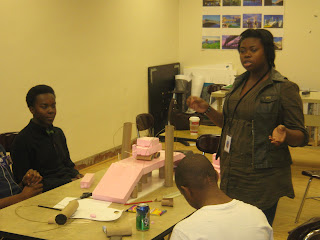On Wednesday, December 15 the James Rhode students learned about several bridge engineering principles using simple materials. Divided into teams of four the students tackled the task of constructing models of an arch bridge, beam bridge, suspension bridge, and cable-stayed bridge. The students were asked to consider the forces acting on each type of bridge and prepare diagrams to document their findings.
For the arch bridge the students used a piece of cardboard for the arch and textbooks for abutments. By pushing on the top of the cardboard and removing one of the textbooks the students learned the importance of the abutments in transferring the load to the ground and maintaining the structural integrity of the bridge. The arch was found to be under compression transmitting the force to the abutments.
 For the beam bridge the students used an eraser for a beam. The students made notches in the top and bottom of the eraser and placed it between two textbooks. By pushing on the top of the eraser the students learned how the top notch tried to squeeze together in compression and the bottom notch tried to spread apart under tension.
For the beam bridge the students used an eraser for a beam. The students made notches in the top and bottom of the eraser and placed it between two textbooks. By pushing on the top of the eraser the students learned how the top notch tried to squeeze together in compression and the bottom notch tried to spread apart under tension.For the suspension bridge the students used string for cables, and textbooks for piers and anchorages. By pushing on the string between two piers without using anchorages, then doing the exercise again with anchorages, the students learned how the loads were transferred in the bridge. The cables were found to be in tension, transmitting compression to the piers and tension to the anchorages.
 For the cable-stayed bridge the students used string for cables and volunteered one of their team members to act as a pier! One string was placed over the lucky team member’s head and tied to each elbow, and another string was placed over the team member’s head and tied to each wrist. The students were asked to describe where they felt a pushing force, or compression. Each person quickly responded that they felt compression on the top of their head, demonstrating that the pier is in compression and the cables are in tension.
For the cable-stayed bridge the students used string for cables and volunteered one of their team members to act as a pier! One string was placed over the lucky team member’s head and tied to each elbow, and another string was placed over the team member’s head and tied to each wrist. The students were asked to describe where they felt a pushing force, or compression. Each person quickly responded that they felt compression on the top of their head, demonstrating that the pier is in compression and the cables are in tension.Additional information on this activity can be found at http://www.pbs.org/wgbh/nova/bridge/build.html, and additional information on tension and compression can be found at http://science.howstuffworks.com/engineering/civil/bridge.htm.





